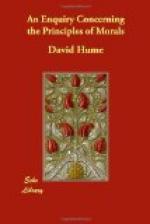III. This doctrine will become still more evident, if we compare moral beauty with natural, to which in many particulars it bears so near a resemblance. It is on the proportion, relation, and position of parts, that all natural beauty depends; but it would be absurd thence to infer, that the perception of beauty, like that of truth in geometrical problems, consists wholly in the perception of relations, and was performed entirely by the understanding or intellectual faculties. In all the sciences, our mind from the known relations investigates the unknown. But in all decisions of taste or external beauty, all the relations are beforehand obvious to the eye; and we thence proceed to feel a sentiment of complacency or disgust, according to the nature of the object, and disposition of our organs.
Euclid has fully explained all the qualities of the circle; but has not in any proposition said a word of its beauty. The reason is evident. The beauty is not a quality of the circle. It lies not in any part of the line, whose parts are equally distant from a common centre. It is only the effect which that figure produces upon the mind, whose peculiar fabric of structure renders it susceptible of such sentiments. In vain would you look for it in the circle, or seek it, either by your senses or by mathematical reasoning, in all the properties of that figure.
Attend to Palladio and Perrault, while they explain all the parts and proportions of a pillar. They talk of the cornice, and frieze, and base, and entablature, and shaft, and architrave; and give the description and position of each of these members. But should you ask the description and position of its beauty, they would readily reply, that the beauty is not in any of the parts or members of a pillar, but results from the whole, when that complicated figure is presented to an intelligent mind, susceptible to those finer sensations. Till such a spectator appear, there is nothing but a figure of such particular dimensions and proportions: from his sentiments alone arise its elegance and beauty.
Again; attend to Cicero, while he paints the crimes of a Verres or a Catiline. You must acknowledge that the moral turpitude results, in the same manner, from the contemplation of the whole, when presented to a being whose organs have such a particular structure and formation. The orator may paint rage, insolence, barbarity on the one side; meekness, suffering, sorrow, innocence on the other. But if you feel no indignation or compassion arise in you from this complication of circumstances, you would in vain ask him, in what consists the crime or villainy, which he so vehemently exclaims against? At what time, or on what subject it first began to exist? And what has a few months afterwards become of it, when every disposition and thought of all the actors is totally altered or annihilated? No satisfactory answer can be given to any of these questions, upon the abstract hypothesis of morals; and we must at last acknowledge, that the crime or immorality is no particular fact or relation, which can be the object of the understanding, but arises entirely from the sentiment of disapprobation, which, by the structure of human nature, we unavoidably feel on the apprehension of barbarity or treachery.




